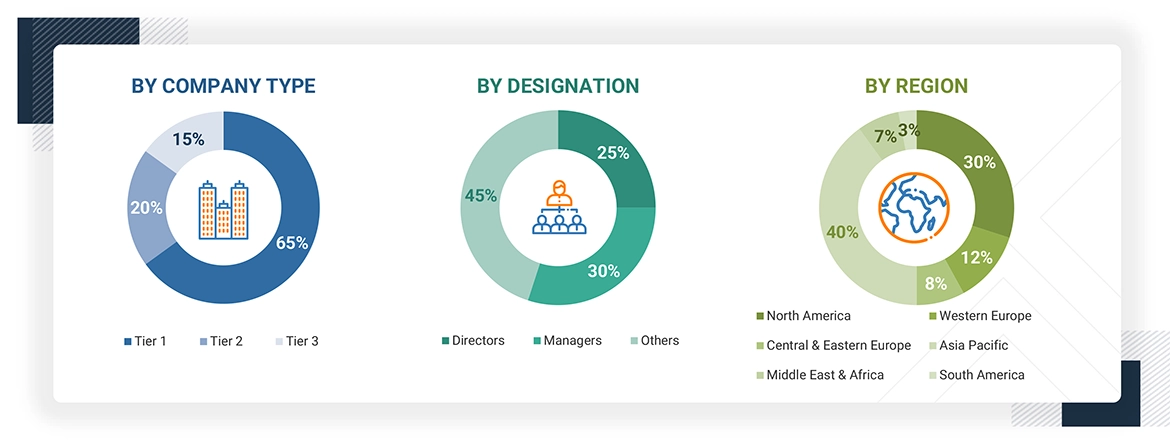The research involved four main steps in assessing the current size of the sulfuric acid market. Comprehensive secondary research was carried out to collect information on the overall market, the related markets, and the core market. The next step was to validate these findings, assumptions, and measurements with industry experts across the sulfuric acid supply chain through primary research. The total market size was determined using both top-down and bottom-up approaches. Afterward, market segmentation analysis and data triangulation were applied to define the sizes of market segments and sub-segments.
Secondary Research
The research approach used to evaluate and forecast the access control market begins with collecting revenue data from leading suppliers through secondary research. Various sources, such as D&B Hoovers, Bloomberg BusinessWeek, Factiva, the World Bank, and industry magazines, were employed to gather information for this study. These sources included annual reports, press releases, and investor presentations from companies; white papers; reputable periodicals; writings by respected authors; statements from regulatory agencies; trade directories; and databases. Vendor offerings have also been analyzed to determine market segmentation.
Primary Research
The sulfuric acid market includes various stakeholders, such as manufacturers, suppliers, traders, associations, and regulatory organizations involved in the supply chain. On the demand side, growth is driven by industries like fertilizers, chemical manufacturing, textiles, automotive, pulp & paper, and other applications. On the supply side, advancements in technology are prominent. To gather both qualitative and quantitative data, interviews were conducted with key sources from both the supply and demand sides.
The following is a breakdown of the primary respondents:

To know about the assumptions considered for the study, download the pdf brochure
Market Size Estimation
Both the top-down and bottom-up approaches were employed to estimate and verify the overall size of the sulfuric acid market. These methods were also widely used to determine the size of various sub-segments within the market. The research methodology used to calculate the market size included the following:
-
The key players were identified through extensive primary and secondary research.
-
The value chain and size of the sulfuric acid market, in terms of value, were determined through primary and secondary research.
-
All percentage shares, splits, and breakdowns were determined using secondary sources and verified through primary sources.
-
All possible parameters affecting the market covered in this research were considered, examined in detail, verified through primary research, and analyzed to obtain the final quantitative and qualitative data.
-
The research included studying reports, reviews, and newsletters of top market players and extensive interviews for insights from key leaders such as CEOs, directors, and marketing executives.
Global Sulfuric Acid Market Size: Bottom-Up and Top-Down Approach
Data Triangulation
After estimating the overall market size using the methods described above, the market was divided into various segments and sub-segments. Data triangulation and market breakdown procedures were employed as needed to complete the market engineering process and determine precise statistics for each segment and sub-segment. The global market size was calculated by summing the data from individual countries and regions.
Market Definition
Sulfuric acid is a highly dense, colorless, slightly yellow liquid, one of the most widely used industrial chemicals worldwide. It is mainly produced from raw materials such as elemental sulfur, pyrite ore, and off-gases from base metal smelters, depending on resource availability and production costs. The production process typically uses the Contact Process or the more efficient Double Contact Double Absorption (DCDA) method, designed to maximize conversion efficiency and reduce emissions. Sulfuric acid comes in several grades tailored for different industrial applications, including technical grade for general use, battery grade for lead-acid batteries, and CP grade (chemically pure) for laboratory and precision work. It is also available in various forms, such as concentrated sulfuric acid, tower or Glover acid, chamber or fertilizer acid, battery acid, 66-degree Baume sulfuric acid, and dilute sulfuric acid, depending on concentration and application needs. Its broad range of uses includes fertilizers, metal processing, petroleum refining, chemical manufacturing, pulp and paper production, textile processing, and the automotive industries. The versatility, reactivity, and availability of sulfuric acid make it a fundamental component in many industrial supply chains.
Stakeholders
-
Sulfuric acid manufacturers
-
Sulfuric acid suppliers
-
Sulfuric acid traders, distributors, and suppliers
-
Investment banks and private equity firms
-
Raw material suppliers
-
Government and research organizations
-
Consulting companies/consultants in the chemicals and materials sectors
-
Industry associations
-
Contract Manufacturing Organizations (CMOs)
-
NGOs, governments, investment banks, venture capitalists, and private equity firms
Report Objectives
-
To define, describe, and forecast the size of the global sulfuric acid market in terms of volume and value
-
To provide detailed information regarding the key factors, such as drivers, restraints, opportunities, and industry-specific challenges, influencing the growth of the global sulfuric acid market
-
To analyze and forecast the size of various segments (raw material, grade, form type, process, and application) of the sulfuric acid market based on six major regions—North America, Asia Pacific, Western Europe, Central & Eastern Europe, South America, and the Middle East & Africa—along with key countries in each of these regions
-
To analyze recent developments and competitive strategies, such as agreements, partnerships, product launches, and joint ventures, to draw the competitive landscape of the market
-
To strategically profile the key players in the market and comprehensively analyze their core competencies



Growth opportunities and latent adjacency in Sulfuric Acid Market